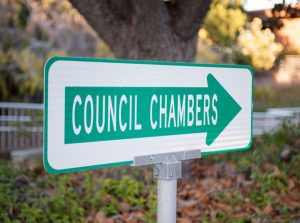You could say the Santa Clara City Council’s 2022 priority-setting session was consistent with established precedent: the Council continued much of the agenda to another meeting, including the goal-setting and a discussion of process and governance.
10-Year Budget Picture: No Relief on the Horizon
Santa Clara continues to have a $17.6 million general fund budget deficit, plus $1 billion in unfunded infrastructure needs. Ongoing budget deficit budgets are forecast for the next five years, despite slight revenue surpluses.
Structural deficits must be addressed in the 23/24/25 and all the short-term budget fixes have been implemented, Santa Clara Finance Director Kenn Lee told the Council. This year the shortfall will be filled from the Budget Stabilization and the land sale reserves — drawing down the Budget Stabilization reserves to $39.8 million.
Residents can look forward to further cuts in City services, new and higher fees, and Santa Clara’s Budget Stabilization reserve dropping to 15 percent — instead of 25 percent — of budget. Barring a dramatic turnaround, this will be the norm for the next five years. Lee noted that Santa Clara’s financial recovery lags that of the rest of Santa Clara County.
Revenues are down slightly over half a million from forecast, while expenses are slightly more than $1 million ahead of forecast.
Property tax revenue — now the City’s single largest general fund revenue source — is expected to grow 5 percent over the next 10 years. Hotel tax, however, hasn’t recovered from the pandemic. This is unlikely to return to its 2018/19 level until 2027/28. Sales tax is also growing slowly. Santa Clara’s sales tax revenue is largely business-to-business sales, and these haven’t seen a comparable boom to retail sales.
Pension costs continue to climb, Lee reported, and Santa Clara’s unfunded pension liability remains at $640 million. Total pension costs are expected to rise about 18 percent over the next ten years — from $55 million to $74 million.
Budget-balancing options under consideration include further drawing down reserves, a hiring freeze, labor concessions, cutting outside services, higher and new fees, and new taxes and a general obligation bond that could add to property taxes. Increases to the City’s business tax, a Utility User tax (which would have to be approved by voters), increasing the documentary transfer tax and new and higher impact fees are under consideration to boost general fund revenue.
To address the billion dollar infrastructure shortfall, City Hall hired public opinion research firm Lew Edwards Group to test public support for ballot measures and found a utility tax could pass the two-thirds bar with voters, but that an infrastructure bond wouldn’t.
Unsurprised at the findings, council members agreed on building support for an infrastructure bond as a long-term goal, perhaps for the 2024 ballot.
Outstanding Pandemic Response, But a Severely Overloaded Workforce
The City’s most notable achievement over the last two years has been its response to the COVID-19 pandemic, noted City Manager Deanna Santana, with a broad range of programs directly helping residents with rental assistance, several food programs, small business grants and COVID testing.
Santana’s picture of the other side of the ledger was grim, focused on the City’s personnel problems, and the apparently paralyzing effect of the City Attorney’s departure on City operations.
A pared-down staff and the general labor shortage have combined with the pandemic to overload City staff and “revealed how shallow our bench is,” said Santana. Santa Clara has a 17 percent vacancy rate, and for some employees, “40 to 60-plus hours per week is the norm…This is not sustainable,” said Santana.
The City Manager seemed to lay many of these problems at the Council’s door. She pointed to Council-generated new work — for example, the new homelessness task force — causing “significant workload, impaired function, and burden on the organization for complex legal services needs.” She blamed the inability to hire a new City Attorney position on “lack of work-life balance,” “Council dynamics” and the “treatment of staff.”
She also noted public records requests as an overwhelming workload, also burdening the short-staffed City Attorney’s office.* New laws and a growing number of development projects create additional burden.
The solution to these problems, Santana said, was to “Stay focused on fiscal and workforce wellness” and “make” capacity by suspending work that is “nice to have” or can be completed later, with a moratorium on new taskforces and committees, and actions that add to staff workload.
Skepticism About Paralyzing Effect of City Attorney Vacancy
Council members criticized what they called “excuses,” noting that other cities faced identical problems and had City Attorney vacancies yet weren’t immobilized like Santa Clara.
“What I heard in the last 30, 40 minutes is reasons why we can’t do things,” said Council Member Anthony Becker. “We can’t put all the blame on one person or on the pandemic… or the City Attorney’s office.”
Council member Suds Jain asked, “if everything is so critical, why do we not have eight attorneys in the City?”
“We are overemphasizing the City Attorney,” said Council Member Raj Chahal. “We had [analysis showing the City needed] eight attorney positions over the years. How many did we hire? If one person leaves and we have so many problems, there’s something wrong. How many of commissions and committees require an attorney’s presence?”
Chahal pointed out revenue-increasing proposals were made — and shot down — that would have helped today.
“When I was first on the Council, I proposed raising the business license [fee]. If we had done that, we would have millions more,” said Chahal. “I proposed a City bus service. I was shut down. We lost grants because [of] this and we lost an opportunity to improve the quality of life.”
“Instead of solutions, we’re trying to lay blame,” said Council Member Kevin Park. “And that isn’t where the work needs to be — eight slides about why this [lack of a City Attorney] is a bad thing. We’re not coming here to rehash the bad things. We’re here to try to get this done.”
Santana said the point was being missed. Problems in City Attorney’s office were examples of how the City was understaffed and “on a critical path” with “nine months to course correct.”
Mayor Lisa Gillmor then interjected her oft-repeated mantra that the problems were the fault of five council members who “fired the City Attorney at the request of the 49ers.”
This touched off a discussion — to be continued on March 1 — of the City’s besetting problem: lies, personal attacks, and outrageous rudeness that have become synonymous with the Santa Clara City Council under Gillmor’s leadership.
“I think we need to look at the real problem,” said Park. “Our inability to be civil and work with people we don’t agree with is a problem.”
Reports and presentations are available at santaclaraca.gov for the meeting. The follow-up meeting will be March 1, 2022. Besides the goal-setting for 2022, the Council will also discuss continuing to elect the police chief and city clerk.
*The biggest currently open records request — a dragnet with 26 items — comes from former City Attorney Doyle’s lawyer, #21-780.












The “norm for the next five years?” Those who do not learn history are doomed to repeat it!
In 2015 the average peace officer in the City of Santa Clara received $127,175 base salary, by 2020 that rose 26% to $160,041. In neighboring Campbell, the average peace officer receives $132,120 salary and Sheriff’s Deputies patrolling neighboring Saratoga and Cupertino receive $126,149 annual salary. There is no reason why the City of Santa Clara should be paying their peace officers more than Campbell and SCCSO, if Santa Clara cut base salaries to meet the other two, the city would save somewhere between $13M-$16M from just the rank and file alone in the next five years. Calculate in cost savings from pension obligations, the city would save somewhere around $20M.
The former city attorney was a financial problem for the city, challenging the California Voters Rights Act cost taxpayers $5 million. Likely not firing problematic officers like Nathan Crescini, Greg Deger, Colin Stewart, Greg Hill, and others has also cost taxpayers millions in police excessive force judgments and settlements.
On behalf of all residents and visitors, the City Council would be wise to terminate election of the City Clerk and Police Chief. Santa Clara has had the highest percentage of officers charged and convicted of crimes and involved in shootings of mentally challenged persons. Immediate accountability needs to be brought back to city council, city manager, and director of human resources; residents shouldn’t have to wait four years to hold anyone accountable.
OK you liberal trash in Santa Clara. Get rid of the mayor. Fire the manager – no severance. Let the stadium book events TO MAKE MONEY. And stop whining.
Making money in a free market wouldn’t be very liberal, Jim. Fiscally conservative in a free market would mean, for example, booking more events at Levi’s Stadium to earn revenue while at the same time managing expenses so that taxpayers are living within their means and building a fiscally sound safety net. Liberals, on the other hand, would want other people to raise funds so they can economically strip the coffers for benefits outside interests of the taxpayer. Paying a regular beat cop $160k annually when the town next door is paying an equally qualified and productive peace officer $126k is not a value for residents and taxpayers living in the City of Santa Clara. Same salary comparison goes for firefighters and public employees.
And what have the 49er’s done for us, they don’t want to pay their bills on time and always want a reduction to boot. All they have done is cost the city money. They will put millions of dollars to put people on the city council to do their bidding for them and cost the city more money and loss of revenue. Lisa stands up for the city and fights them on what was already in the contracts. All the 49er’s do is want to run everything that saves them money and costs us. We need to stop them.